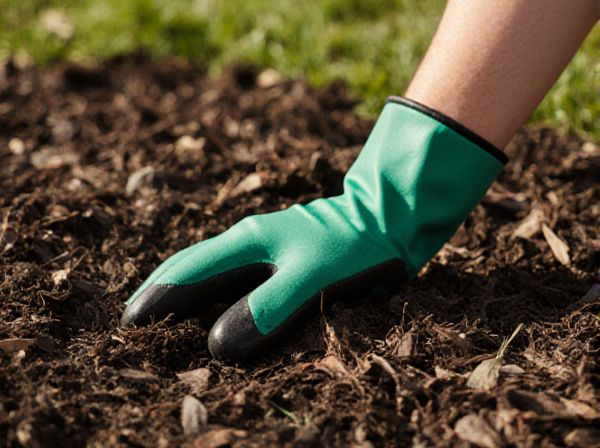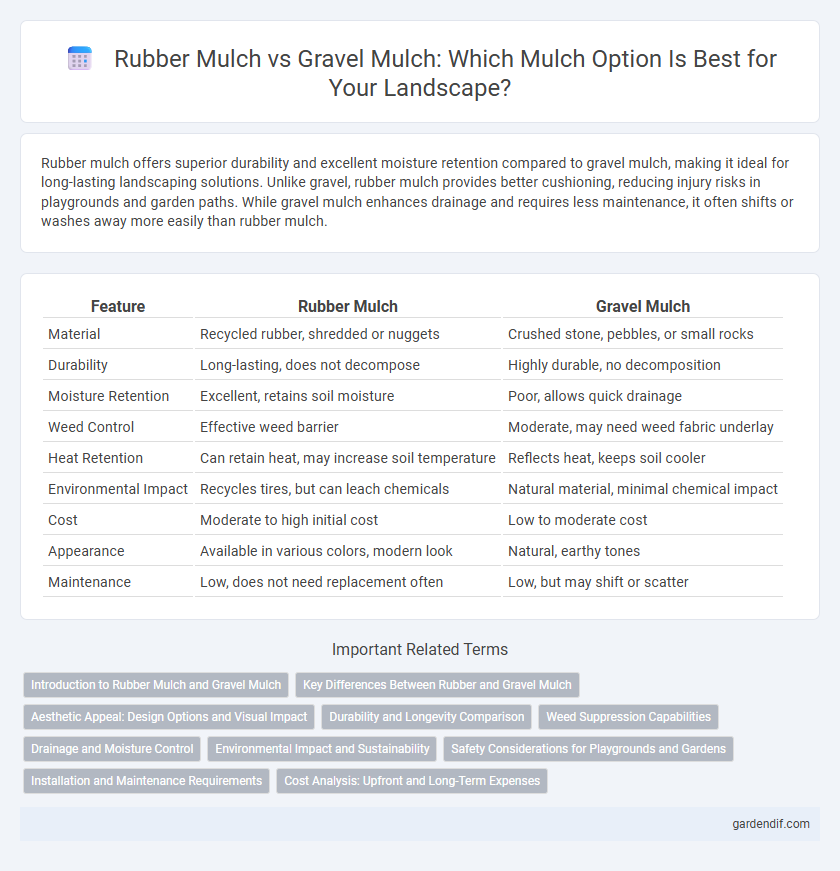
Rubber mulch vs gravel mulch Illustration
Rubber mulch offers superior durability and excellent moisture retention compared to gravel mulch, making it ideal for long-lasting landscaping solutions. Unlike gravel, rubber mulch provides better cushioning, reducing injury risks in playgrounds and garden paths. While gravel mulch enhances drainage and requires less maintenance, it often shifts or washes away more easily than rubber mulch.
Table of Comparison
| Feature | Rubber Mulch | Gravel Mulch |
|---|---|---|
| Material | Recycled rubber, shredded or nuggets | Crushed stone, pebbles, or small rocks |
| Durability | Long-lasting, does not decompose | Highly durable, no decomposition |
| Moisture Retention | Excellent, retains soil moisture | Poor, allows quick drainage |
| Weed Control | Effective weed barrier | Moderate, may need weed fabric underlay |
| Heat Retention | Can retain heat, may increase soil temperature | Reflects heat, keeps soil cooler |
| Environmental Impact | Recycles tires, but can leach chemicals | Natural material, minimal chemical impact |
| Cost | Moderate to high initial cost | Low to moderate cost |
| Appearance | Available in various colors, modern look | Natural, earthy tones |
| Maintenance | Low, does not need replacement often | Low, but may shift or scatter |
Introduction to Rubber Mulch and Gravel Mulch
Rubber mulch, composed of recycled tires, offers superior durability, excellent moisture retention, and effective weed control compared to gravel mulch, which consists of natural stones providing better drainage and a more traditional landscape aesthetic. Rubber mulch is lightweight and does not compact, making it ideal for playgrounds and garden beds, while gravel mulch is favored for pathways and xeriscaping due to its low maintenance and erosion resistance. Both mulches serve distinct landscaping needs, with rubber mulch excelling in impact absorption and gravel mulch enhancing soil aeration.
Key Differences Between Rubber and Gravel Mulch
Rubber mulch, made from recycled tires, offers superior cushioning, durability, and weed prevention compared to gravel mulch, which consists of natural stones and provides excellent drainage and a more natural aesthetic. Rubber mulch is lightweight and less prone to displacement, whereas gravel mulch is heavier and can shift easily but does not retain heat as much as rubber. Both types vary in cost, with rubber mulch typically being more expensive upfront but longer-lasting, while gravel mulch requires less maintenance but may need replenishment over time.
Aesthetic Appeal: Design Options and Visual Impact
Rubber mulch offers vibrant color options and a uniform texture, enhancing landscape aesthetics with a clean, modern appearance, while gravel mulch provides a natural, earthy look that complements rustic and traditional garden styles. Rubber mulch's flexible design allows for bold, bright landscapes that resist fading, whereas gravel mulch adds depth and contrast with its variety of sizes and colors, promoting a more organic visual impact. Both materials contribute to aesthetic appeal, but rubber mulch excels in maintaining vividness and versatility, while gravel mulch supports a timeless, natural ambiance.
Durability and Longevity Comparison
Rubber mulch offers superior durability compared to gravel mulch, as it resists weathering, fading, and compression over time, maintaining its appearance and cushioning effect for up to 10 years or more. Gravel mulch, while effective for drainage and preventing weed growth, tends to scatter, settle, and degrade, requiring frequent replenishment every 2 to 3 years. The rubber mulch's resilience to UV exposure and heavy foot traffic ensures longer-lasting landscape appeal and reduced maintenance costs.
Weed Suppression Capabilities
Rubber mulch offers superior weed suppression compared to gravel mulch due to its dense, non-porous surface that blocks sunlight, preventing weed seed germination effectively. Gravel mulch, while providing some barrier, allows more light and air penetration, making it less efficient at inhibiting weed growth. Studies show rubber mulch can reduce weed emergence by up to 75%, outperforming traditional gravel mulch in maintaining a cleaner, low-maintenance landscape.
Drainage and Moisture Control
Rubber mulch provides excellent drainage while retaining moisture better than gravel mulch, which tends to allow water to drain quickly without significant moisture retention. Unlike gravel, rubber mulch helps reduce soil erosion by maintaining consistent moisture levels around plant roots. Its porous structure enables efficient water flow, preventing waterlogging and promoting healthier root growth.
Environmental Impact and Sustainability
Rubber mulch, derived from recycled tires, offers durability and reduces landfill waste but may release harmful chemicals over time, impacting soil and water quality. Gravel mulch is natural, enhances soil drainage, and has a low environmental footprint but can contribute to heat retention and habitat disruption if not sourced sustainably. Choosing mulch involves balancing the longevity and reuse benefits of rubber with the natural composition and ecological effects of gravel.
Safety Considerations for Playgrounds and Gardens
Rubber mulch provides superior cushioning and shock absorption, significantly reducing the risk of injury in playgrounds compared to gravel mulch, which can cause abrasions or pose choking hazards. Rubber mulch is non-toxic, does not decompose easily, and resists mold and insects, enhancing safety and longevity in garden applications. Gravel mulch, while effective for drainage, may create sharp edges and is less effective in preventing slips or falls, making rubber mulch a safer choice for areas frequented by children.
Installation and Maintenance Requirements
Rubber mulch installation involves spreading shredded or molded rubber pieces, requiring a landscape fabric base to prevent weed growth and ensure durability. Gravel mulch installation requires laying a weed barrier fabric followed by evenly distributing gravel, with attention to proper depth for effective weed control and drainage. Maintenance for rubber mulch is low, involving occasional raking to redistribute material, while gravel mulch requires periodic replenishment and removal of debris to maintain appearance and function.
Cost Analysis: Upfront and Long-Term Expenses
Rubber mulch generally has a higher upfront cost compared to gravel mulch, but its durability and low maintenance reduce long-term expenses significantly. Gravel mulch is more affordable initially but may require periodic replenishing and weed control, increasing ongoing costs. Evaluating total lifecycle expenses shows rubber mulch often offers better value for investment in landscaping projects.
Rubber mulch vs gravel mulch Infographic

 gardendif.com
gardendif.com